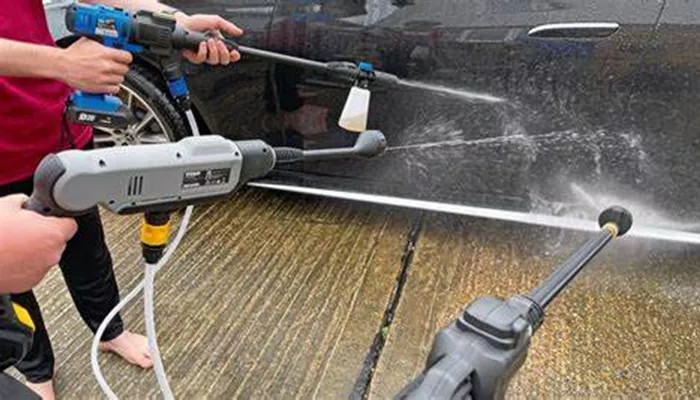A pressure washer that refuses to spray can be a real headache. Whether you’re in the middle of a big cleaning project, like washing your driveway or prepping your deck for a new coat of paint, this issue can bring your progress to a halt. Understanding why your pressure washer isn’t spraying is the first step to getting it back in working order. In this article, we’ll explore the common causes behind this problem and how you can troubleshoot them.
Water Supply Issues
Empty or Low Water Source
The simplest reason a pressure washer might not spray is that the water source is empty or has a low water level. If you’re using a bucket or a tank as your water source, it’s easy to overlook this. Even if you’re connected to a faucet, there could be a problem with the water supply in your area, like a water main break or a temporary shutdown for maintenance.
Check the water source visually. If it’s a bucket or tank, make sure it’s filled to an appropriate level. If you’re connected to a faucet, check other taps in your house to see if water is flowing. If there’s no water anywhere, contact your local water utility company to inquire about any outages or issues. If the problem is just a low – level water source, refill it and try running the pressure washer again.
Clogged Water Inlet or Filters
The water inlet of the pressure washer, along with any built – in filters, can become clogged over time. Dirt, debris, and even small particles from the water can accumulate, blocking the flow of water into the machine. If your pressure washer has a removable water inlet filter, it’s a common culprit.
To clean the water inlet, first, turn off the water supply and disconnect the pressure washer from the water source. Remove the water inlet filter (if there is one) and inspect it for dirt and debris. You can use a small brush, like an old toothbrush, to clean the filter thoroughly. If there’s no filter, check the water inlet itself for any blockages. Use a pipe cleaner or a small wire to gently remove any debris. After cleaning, reassemble the parts and reconnect the pressure washer to the water source. Test it to see if the spraying problem has been resolved.
Kinked or Blocked Water Hoses
The water hoses that connect the pressure washer to the water source play a crucial role in delivering water. If these hoses get kinked, bent at a sharp angle, or blocked with debris, water flow will be restricted or completely stopped. Kinks can happen when the hose is coiled tightly or dragged over sharp objects. Debris, such as leaves or small stones, can enter the hose from the water source and cause blockages.
Inspect the entire length of the water hose for kinks. If you find a kink, carefully straighten it out. If the hose is blocked, disconnect it from both the pressure washer and the water source. Try flushing the hose with water from a faucet or a garden hose. You may need to use a brush or a long, thin object to push out any stubborn debris. Once the hose is clear, reconnect it and test the pressure washer.
Other Potential Causes
Air in the System
Air in the water – supply system of the pressure washer can also cause spraying problems. Air can enter the system when the water source runs dry, there’s a leak in the water intake hose, or during the initial start – up of the pressure washer. When air is present, it can disrupt the water flow and prevent the pump from building up the necessary pressure.
To remove air from the system, first, make sure the water source is properly filled and that there are no leaks in the water intake hose. Then, start the pressure washer and let it run for a few minutes with the spray gun trigger pulled. This will allow the water to flush out any air that may be in the system. If the problem persists, some pressure washers have a bleed valve that you can open to release the air. Open the bleed valve until a steady stream of water comes out, then close it.
Frozen Components
In cold weather, the water inside the pressure washer can freeze, especially if the machine has been left outside or in an unheated area. Frozen components, such as the pump, hoses, or nozzle, can prevent the pressure washer from spraying. The ice can block the water passages and even cause damage to the components if they expand due to freezing.
If you suspect that your pressure washer has frozen components, bring it indoors and let it thaw gradually. Do not use heat sources like a blowtorch or a hot plate to thaw the machine, as this can cause damage. Once the machine has thawed, check for any signs of damage, such as cracks in the hoses or pump housing. If there is damage, you may need to replace the affected components. Then, test the pressure washer to see if it sprays properly.
Conclusion
When your pressure washer isn’t spraying, there can be multiple underlying causes. By systematically checking the water supply, pump, nozzle, power source, and other components, you can identify and fix the problem. Remember to always refer to the user manual for your specific pressure washer model when troubleshooting and making repairs. If you’re still unable to resolve the issue after trying these steps, it may be time to consult a professional technician or the manufacturer’s customer support for further assistance. With a little patience and some basic knowledge, you can get your pressure washer back to its powerful spraying self and resume your cleaning projects.
Related topics:
How Effectiveness is Steam Cleaning Carpets?

